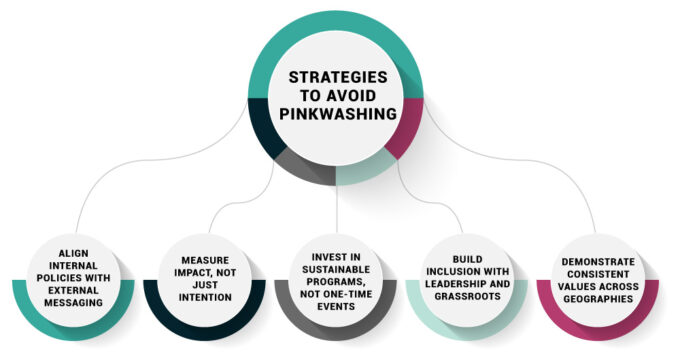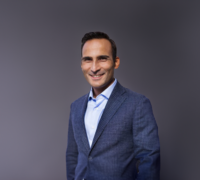
The value of LGBTQ+ inclusion in today’s uncertain DE&I landscape
Companies gain performance advantages through LGBTQ+ inclusion, yet nearly nine in 10 Swiss firms lag. Here’s how leaders can close the gap....

by Luca Condosta Published May 29, 2025 in Diversity, Equity, and Inclusion • 8 min read
As public discourse around diversity, equity, and inclusion (DE&I) grows more polarized, the current backlash is testing which companies truly stand behind their values, and which merely pay lip service. Luca Condosta shares perspectives from his work with several organizations, where he has witnessed both effective approaches and missteps in corporate LGBTQ+ inclusion efforts. The challenge today is clear: how can organizations move beyond performative gestures to offer meaningful, lasting support for LGBTQ+ rights?
The democratization of social media has intensified scrutiny of corporate DE&I initiatives. Stakeholders, from employees to customers, can quickly identify and call out inconsistencies between external messaging and internal practices. Companies that change their logos for Pride Month while failing to implement supportive policies internally face a growing backlash. This phenomenon, known as “pinkwashing,” occurs when businesses appear to support LGBTQ+ communities primarily for marketing benefits without substantive commitment to inclusion.
Several high-profile pinkwashing controversies highlight this disconnect as companies have faced criticism for Pride-themed marketing campaigns that rang hollow when compared to their internal policies or political contributions.
Companies engaged in true inclusion must align external communications with internal policies and ensure their supply chain and business partnerships reflect the values they publicly promote during Pride Month.
Back in 2021, and despite promoting diversity and inclusion in marketing campaigns, H&M demonstrated the gap between messaging and substantive action. While selling Pride collections, the company donated merely 10% of proceeds to LGBTQ+ charities. Simultaneously, H&M sourced products from countries with documented human rights violations. This inconsistency highlights classic pinkwashing – leveraging LGBTQ+ imagery for commercial benefit without addressing fundamental inclusion challenges within operations. Companies engaged in true inclusion must align external communications with internal policies and ensure their supply chain and business partnerships reflect the values they publicly promote during Pride Month.
Source: World Law Form (2021)
Good intentions are insufficient in today’s environment. Companies must recognize that authentic inclusion requires concrete action supported by consistent messaging both internally and externally. Our experience implementing LGBTQ+ initiatives has shown that a structured, multi-year approach yields the most sustainable results.

We began with building awareness and establishing foundations, intentionally resisting the temptation to participate in external Pride celebrations until we had substantive internal policies in place. “We won’t celebrate until we’ve fixed our policies first,” became our guiding principle. We secured executive sponsorship, established Employee Resource Groups (ERG), signed the UN Code of Conduct for LGBTQ+ Anti-discrimination, and formed strategic partnerships with organizations like Open for Business.
As momentum grew, we moved from awareness to action, strengthening executive sponsorship while growing ERG membership across global locations. We implemented leadership development programs specifically for LGBTQ+ employees and launched a reverse mentoring initiative that paired senior leaders with LGBTQ+ employees from different regions.
“One eye-opening discovery was that in some countries people didn't feel comfortable ‘coming out’, even when the country the business was located in was open and safe."
We complemented these efforts with allyship campaigns featuring clear, actionable steps for allies at different levels of engagement.
With foundations and actions in place, we then focused on embedding inclusion into the organization’s infrastructure through systemic changes. We revised our code of conduct to explicitly mention zero tolerance for gender and anti-LGBTQ+ discrimination, conducted comprehensive reviews of all benefit policies, and utilized external assessments like the Workplace Pride Index to measure progress.
Our “Come As You Are” campaign signaled this deeper integration, while we simultaneously expanded advocacy beyond company walls. The policy review was particularly thorough, covering everything from parental leave and life insurance cover to retirement plans and company cars, ensuring inclusive benefits for all employees regardless of their identity or relationship status.
Burger King’s 2021 “Pride Whopper” campaign demonstrates the consequences of misaligned DE&I initiatives. The campaign, featuring rainbow-wrapped burgers and ‘same-sided’ buns, backfired spectacularly. Critics condemned it as pinkwashing – capitalizing on Pride without meaningful organizational commitment to LGBTQ+ inclusion. The LGBTQ+ community found the campaign tone-deaf, reducing complex identities to burger wrappers. Despite partnerships with advocacy groups, the initiative was perceived as superficial in the absence of substantial internal policy changes. The company quickly deleted campaign materials following the backlash. This example highlights how performative gestures, without authentic organizational inclusion policies, damage brand reputation and alienate the very communities companies claim to support.
Source: The Unhappy Meal (2023)

Based on our experience implementing authentic LGBTQ+ inclusion programs, we found these strategies contributed to our progress:
Get the foundation right first. Scrutinize your organization’s policies and practices before launching Pride-related external communications or events. Parental leave policies, for example, should recognize all types of families. Many companies today redesigned their parental leave policies to focus on supporting “primary caregivers”, rather than traditional gender roles or relationship structures. This approach allows all partners to grow and take an equal stake in managing family matters while progressing with their careers.
Move beyond input and representation metrics to measure systemic changes and their impact. The Workplace Pride Index and similar frameworks provide comprehensive assessment tools covering multiple dimensions of inclusion. Track both process metrics (policies implemented, training conducted) and outcome metrics (employee engagement, retention of diverse talent).
Pride Month activities should be part of a year-round inclusion strategy, not isolated events. While Pride Month has a strong celebration connotation for the LGBTQ+ community, it can also be a boomerang if not properly managed. Ideally, it should be leveraged as a moment to come back to the employees to educate them, while celebrating the achievements collected so far.
A combined approach of tone from the top and movement from the bottom can pay more, accelerating the journey and ensuring that middle management embraces the change too.
Successful LGBTQ+ inclusion requires both executive sponsorship and employee engagement. Don’t bet all on the top leaders. A combined approach of tone from the top and movement from the bottom can pay more, accelerating the journey and ensuring that middle management embraces the change too. This dual approach creates sustainable momentum that outlasts leadership changes.
While legal requirements vary across countries, company values should remain consistent globally. When navigating complex political environments, focus on creating safe spaces for employees rather than retreating from inclusion commitments. As observed during recent political shifts, the moment we step back, or just make it fluffy, then this will backfire, because stakeholders are probably going to keep you accountable.

Rather than retreating from inclusion commitments, prompted by the shifting landscape around DE&I initiatives, forward-thinking organizations can seize this moment to strengthen and consolidate their approach.
With mounting political tensions surrounding workplace inclusion efforts, especially in the US, where DE&I faces increasing scrutiny, companies should maintain their core inclusion values while adapting their communication approach. Instead of going silent (‘pink-hushing’), focus on framing inclusion as beneficial for all employees and align initiatives with business performance and talent retention, thus avoiding politically charged terminology that might unnecessarily polarize stakeholders.
When facing external pressure, examine whether your DE&I initiatives create equal opportunities for all rather than special privileges for some. For example, inclusive parental leave policies that focus on caregiving roles rather than gender or relationship structure benefit all employees while avoiding claims of preferential treatment.
The current threat is on DE&I. Tomorrow, it’s going to be sustainability. The day after, it’s going to be integrity. You completely lose credibility if your values are so negotiable and you change direction with the wind. Companies that maintain their values during challenging times build credibility with stakeholders across the political spectrum, especially their employees.
After chairman Guido Barilla’s 2013 anti-LGBTQ+ comments suggesting gay customers “eat another pasta,” Barilla faced worldwide boycotts despite initial apologies. Rather than abandoning inclusion efforts, the company embarked on a comprehensive transformation. Barilla appointed a Chief Diversity Officer, consulted with LGBTQ+ organizations, and revamped internal policies. The company’s recovery demonstrates the difference between tactical crisis communications and authentic inclusion. By embracing organizational change rather than merely improving messaging, Barilla transformed its approach from reactive damage control to proactive inclusion. Their recovery shows how companies can rebuild trust through substantive policy changes and consistent actions aligned with stated values.
The distinction between pinkwashing and authentic inclusion ultimately comes down to depth and consistency. Superficial changes like temporary logo modifications or awareness campaigns must be backed by substantive policy changes, leadership commitment, and ongoing engagement.
By addressing these questions honestly and committing to continuous improvement, organizations can move beyond pinkwashing to create genuinely inclusive environments where all employees can truly “Come As You Are.”
This article was developed based on ABB’s multi-year journey implementing LGBTQ+ inclusion initiatives across a global organization, as well as insights from collaboration with other leading companies committed to authentic inclusion.

Head of Social Progress and Sustainability Capability building, LGBTQ+ Global Program
Luca Condosta is a transformational leader with a robust track record of driving change at the intersection of people, sustainability, and data. With a deep commitment to diversity, equity, and inclusion, his expertise spans over 20 years across multiple sectors, including telecommunications, oil and gas, and energy. He holds a PhD in business administration from Catholica University (Milan) with a focus on sustainability strategy, and master’s degrees in sustainable leadership, and business and climate change from Cambridge University. Luca was named on the 2024 Outstanding Role Model List that recognizes executives who paved the way for LGBTQ+ inclusion at work.

October 24, 2025 • by Luca Condosta, Alexander Fleischmann in Diversity, Equity, and Inclusion
Companies gain performance advantages through LGBTQ+ inclusion, yet nearly nine in 10 Swiss firms lag. Here’s how leaders can close the gap....

October 21, 2025 • by Vanina Farber in Diversity, Equity, and Inclusion
When talk of diversity triggers backlash, leaders face a paradox: how to advance inclusion goals while choosing language that keeps dialogue alive in hostile environments....

August 20, 2025 • by Francesca Annalisa Petrella, Fernando Alonso Pérez-Chao, Luca Condosta in Diversity, Equity, and Inclusion
While support for workplace LGBTQ+ programs has dropped to just 38% globally, cities with strong inclusion policies demonstrate four times higher human capital performance and double the innovation scores than their less...

July 11, 2025 • by Silke Mischke in Diversity, Equity, and Inclusion
While some organizations retreat from inclusion commitments under political pressure, the path to lasting transformation lies in embedding diversity deeply within core values rather than treating it as a compliance issue. Leaders...
Explore first person business intelligence from top minds curated for a global executive audience